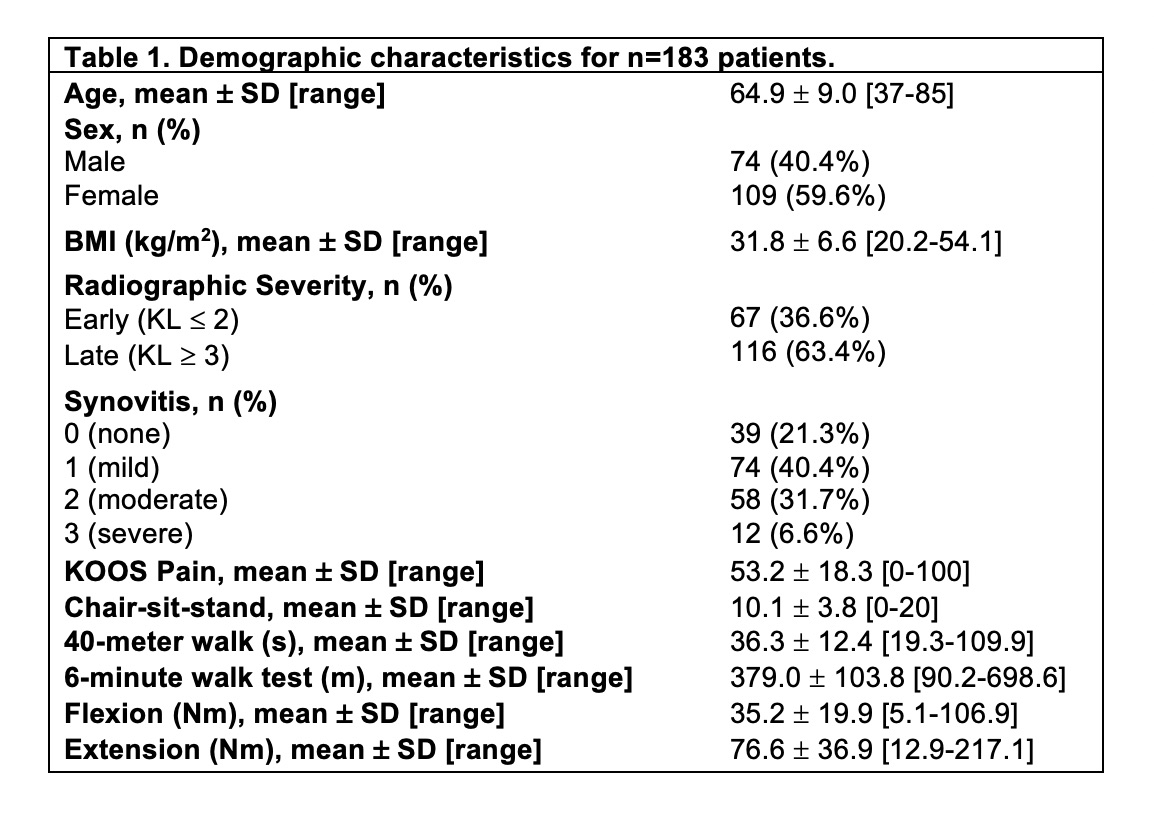Session Information
Session Type: Poster Session C
Session Time: 9:00AM-11:00AM
Background/Purpose: Signs of inflammation in knee osteoarthritis (OA), including synovitis, are associated with worse clinical outcomes such as increased pain, risk of progression, and future need for knee replacement surgery. To date, no studies have examined the association between ultrasound (US) features of OA and performance-based measures of function or muscle strength in patients with knee OA. Understanding the relationship between imaging features of knee OA and functional limitations, may help guide treatment algorithms and assessment of disease burden. The aim of this study was to assess the association of US-synovitis with performance-based measures of function and muscle strength in patients with knee OA.
Methods: Patients diagnosed with clinical knee OA based on the American College of Rheumatology (ACR) criteria were included in this cross-sectional analysis. Patients completed the Knee injury and Osteoarthritis Outcome Score (KOOS) questionnaire (0-100; lower scores indicate more pain) and a series of performance-based measures of function including the chair-sit-stand test, 40-meter walk test, 6-minute walk test, and quadriceps and hamstring strength (knee extension and flexion peak torque assessed using isokinetic dynamometry). Musculoskeletal-US was used to measure synovitis in the suprapatellar region (0-3; None-Severe). Radiographs were used to obtain Kellgren-Lawrence (KL) grades of OA severity. We fitted a series of multivariate linear regression models to evaluate the association between synovitis (predictor of interest) and performance-based measures of function (outcome), adjusting for age, sex, body mass index (BMI), KL grade, and KOOS Pain. Model outcome measures were 1) 40-meter walk test 2) 6-minute walk test 3) chair-sit-stand test, 4) extension (quadriceps strength), and 5) flexion (hamstring strength). Robust sandwich estimators were used. We reported results as unstandardized β coefficients with 95% confidence intervals (CIs), and robust standard errors. We evaluated for confounding and completed mediation analyses using PROCESS macro v3.5. Mediation results are reported as indirect effect estimates, standard error, and 95% CIs.
Results: Analyses included 183 patients (Table1). Greater synovitis was associated with decreased time for the 40-meter walk test, and increased quadriceps and hamstrings muscle strength, only when adjusting for age, sex, BMI, KL grade, and KOOS Pain (Table 2). Mediation analyses (Figure 1) for each model show that the effect of synovitis (0 vs 3) on performance-based functional outcomes and muscle strength is mediated by KOOS Pain. Indirect effects for 40-meter walk (3.30; SE:1.50; 95%CI: 0.86-6.75), chair-sit-stand (-1.08; SE:0.41; 95%CI: -19.6- -0.36), 6-minute walk test (-29.61; SE: 10.59; 95%CI: -52.67- -10.50), and extension (-5.97; SE: 2.98; 95%CI: -12.43- -0.80) indicate significant mediation.
Conclusion: Important factors such as pain, age, sex, and body size are known to be related to function in knee OA. We demonstrated that US-synovitis is another important factor that should be considered. Moreover, our findings suggest that a complex relationship exists between knee synovitis and physical function that is mediated by pain.
To cite this abstract in AMA style:
Philpott H, Birmingham T, Pinto R, Arsenault D, Primeau C, Vasarhelyi E, MacDonald S, Lanting B, Appleton T. Osteoarthritis-Related Knee Inflammation Measured by Ultrasound Is Associated with Performance-Based Measures of Function [abstract]. Arthritis Rheumatol. 2020; 72 (suppl 10). https://acrabstracts.org/abstract/osteoarthritis-related-knee-inflammation-measured-by-ultrasound-is-associated-with-performance-based-measures-of-function/. Accessed .« Back to ACR Convergence 2020
ACR Meeting Abstracts - https://acrabstracts.org/abstract/osteoarthritis-related-knee-inflammation-measured-by-ultrasound-is-associated-with-performance-based-measures-of-function/



